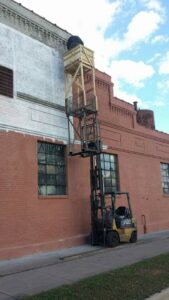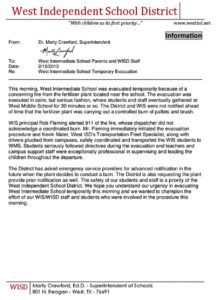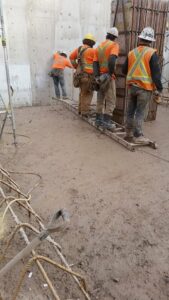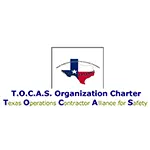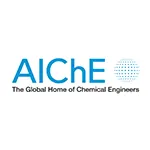April Membership Special
3-years for $100
Just buy a Single User Membership and your $100 gets you three (3) years of access instead of one (1) year
CLICK HERE to Renew your Membership
CLICK HERE for a NEW Membership
CLICK HERE to see eligibility requirements for FREE Membership
If you have any questions, please contact me
SAFTENG has:
- Over 18,000 categorized unsafe acts/conditions and accident/injury photos
- Over 1,500 ppt's & doc's in the SAFTENG Library
- Over 4,000 Technical Articles on Process Safety, Emergency Response & OSH topics
- Over 450 videos (those not allowed on YouTube Channel)
Many THANKS to my NEW Members and those who CONTINUE to support SAFTENG:














February 1, 2016
As we know, 1910.146 gives employers three (3) methods to enter Permit-Required Confined Spaces: 1) Full permitted entry following (d)-(k), 2) alternative entry methods prescribed in (c)(5), and 3) reclassification of the PRCS to a non-permit space by following (c)(7). However, in the past year or so, we have come across another method… using BOTH (c)(5) AND (c)(7) in the same space at the same time....
Read More
January 31, 2016
This incident is a PERFECT example of what can happen when STORED ENERGY is overlooked. For energy sources like hydraulics and pneumatic (e.g., gases), merely closing a valve and locking it closed or locking out a pump is NOT full energy control. Procedures MUST include the means to dissipate the stored energy to the Zero Energy State (ZES). Keeping in mind that sometimes the dissipation...
Read More
January 31, 2016
Respondent is a corporation authorized to do business in the State of Texas. Respondent owns and operates a chemical building, manufacturing, and packaging facility. Respondent receives bulk raw chemicals, including liquid sodium chlorite, delivered in tanker, railcar, and packaged containers. Respondent uses these raw ingredients to produce finished products. Liquid sodium chlorite is an extremely...
Read More
January 30, 2016
Anyone wondering who got him up there? Besides being driver-less, look closely for the other OSHA violation…
Read More
January 29, 2016
Respondent is a fertilizer distributor engaged in the business of selling anhydrous ammonia to farmers as fertilizer. Anhydrous ammonia is classified as a physical or health hazard, and a simple asphyxiant and therefore is an “extremely hazardous substance” according to Section 302(a)(2) of EPCRA. The Respondent stores more than 10,000 lbs. of anhydrous ammonia at the facility. On...
Read More
January 29, 2016
1/29/16 UPDATE – CSB Investigation Video and Investigation Report
…
HomeRead More »
Read More
January 28, 2016
OSHA began a programmed-targeted inspection on July 23, 2015, under the agency’s Process Safety Management Covered Chemical Facilities National Emphasis Program to reduce or eliminate the release of highly hazardous chemicals. Following the inspection of the plant’s anhydrous ammonia refrigeration system, OSHA issued citations for 11 serious and three repeat violations and also placed the...
Read More
January 28, 2016
On Jan. 19, 2016, the Hartford Area Office cited a chemical manufacturer for 15 serious violations of workplace safety standards. Inspectors found that a manufacturer of swimming pool chemicals and acetone preparations used in nail polish were exposed employees to chemical, fire, and exit access hazards. The company’s manufacturing processes use large amounts of the flammable chemicals acetone...
Read More
January 27, 2016
2016 Fatality Tracker Electrical 1 (2015 = 38) (2014 = 55) (2013 = 32) (2012 = 68) Forklift/Aerial 6 (2015 = 48) (2014 = 60) (2013 = 62) (2012 = 52) Mining* 4 (2015 = 21) (2014 = 401) (2013 = 87*) (2012 = 92*) *ONLY USA Explosions 4 (2015 = 135) (2014 = 157) (2013 = 194) (2012 = 241) Cranes 4 (2015 = 28) (2014 = 20) (2013 = 51) (2012 = 52) Falls 8 (2015 = 76) (2014 = 97) (2013...
Read More
January 24, 2016
At the site of an inactive gas well, two workers were flowing the high-pressure gas from the well to determine production potential. They were inside an operator’s shack when a pipe ruptured, and the escaping flammable gas exploded in a fireball. Although the two workers were wearing fire-retardant clothing, they suffered burns. The smaller piping downstream from a pressure relief valve (PRV)...
Read More
January 23, 2016
Yet again we find a group of workers who have failed to recognize the idea of one as UNSAFE. But of course, they are SAFE because they have on all their required PPE, including their hi-vis safety vests.
Read More


